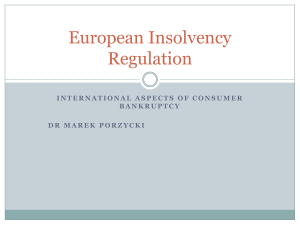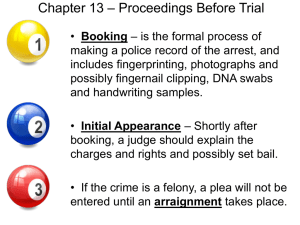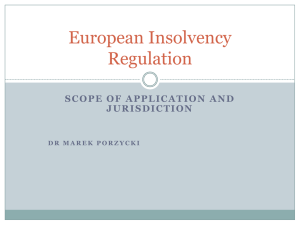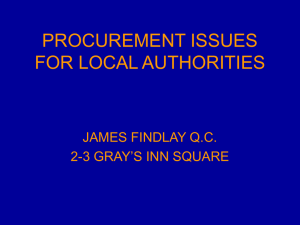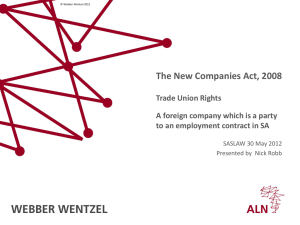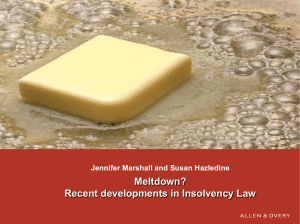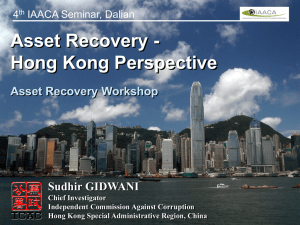Case study
advertisement
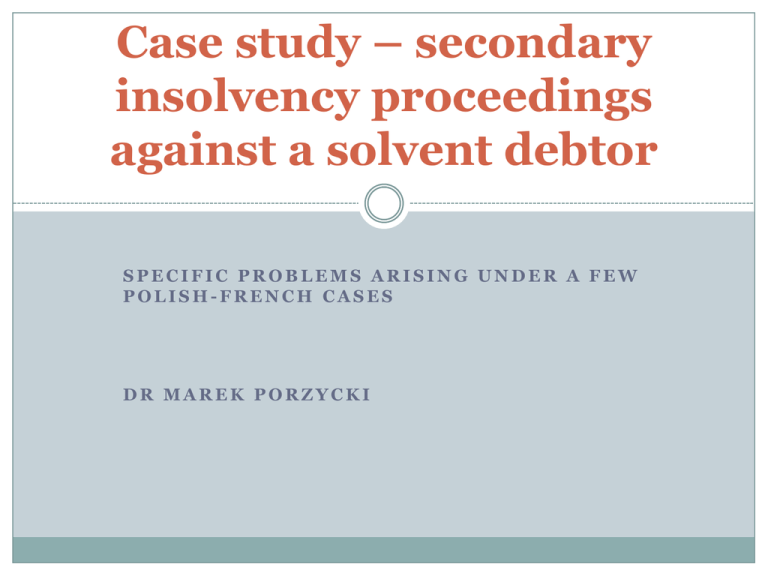
Case study – secondary insolvency proceedings against a solvent debtor SPECIFIC PROBLEMS ARISING UNDER A FEW POLISH-FRENCH CASES DR MAREK PORZYCKI Concept of ‘insolvency proceedings’ under the European Insolvency Regulation initial meaning of Article 1(1) of the EIR Constitutive elements: collective proceedings, insolvency, divestment of the debtor, appointment of a liquidator „a very broad framework“; „conditions which enable proceedings to be added to the lists [in the Annexes]“ (Virgos-Schmit report, paragraph 48) Concept of ‘insolvency proceedings’ question: how far can the term ‘insolvency proceedings’ include restructuring proceedings aiming at avoiding insolvency practice: Member States themselves propose proceedings to be included into Annexes A and B to the EIR expansion beyond the original concept of insolvency proceedings Jurisdiction to open main insolvency proceedings the concept of COMI the first court to open main proceedings maintains jurisdiction – no examination of its jurisdiction by courts in other Member States Result „race to the court” Possibility for an effective opening of main proceedings under questionable grounds for jurisdiction main focus – groups of companies, insolvency proceedings against subsidiaries in other Member States. Consequence for secondary proceedings ‘second price’ for the losing court in a conflict over jurisdiction no examination of insolvency (grounds to open proceedings) ‘automatism of opening’ (Article 27 of the EIR) - duty to open or right to open? secondary proceedings opened always as windingup proceedings (Article 27, Annex B) Back door to automatic opening of winding-up insolvency proceedings against solvent and functioning debtors Real-life cases French sauvegarde proceedings opened against a company of Polish law belonging to a French-led group of companies. Sauvegarde proceedings were opened in parallel against all companies in the group, incorporated in several Member States the entire estate of the debtor was located in Poland, the activities were concentrated in Poland. Economic choices controlled by the parent company in France. Decisions of the management taken partly in Poland partly in France. highly doubtful decision of the French court that COMI was in France the Polish subsidiary was functioning and solvent at the time of the opening of main proceedings. Economic consequence even if COMI is located in France (doubtful but the French court was first to open main proceedings Eurofood), any restructuring efforts would necessarily need to be concentrated in Poland Request for secondary proceedings request to open secondary proceedings lodged to a Polish court by a foreign creditor (a bank incorporated in the U.S.) Is a foreign creditor entitled to lodge request under Article 29(b) of the EIR? Controversy on the provision of Polish law to be applied – Article 20 or 407 of the Bankruptcy and Rehabilitation Law? Incorrect answer of the Polish Supreme Court in the judgment of 20.1.2010, III CZP 115/09, see www.sn.pl (Polish only): Article 407 of the BRL only a Polish creditor can apply for secondary proceedings in Poland Correct answer – any person listed in Article 20 of the BRL (=any creditor) can apply for secondary proceedings Request by a domestic creditor? even interpretation by SN does not prevent the opening of secondary proceedings Result of current provisions of the EIR (as interpreted in Eurofood) Unnecessary opening of secondary proceedings as winding-up proceedings which includes the entire estate of a solvent, functioning debtor. Hampering of restructuring efforts in main proceedings. A disastrous blow to the debtor’s reputation, resulting in a likely loss of business partners. Even if the debtor is not wound up in the result (see below) – a long period of legal uncertainty. Reference of a Polish court to the ECJ Reference by the Bankruptcy Court of Poznań lodged - on 7.3.2011, Case C-116/11, Judgment of 22.11.2012 Practical aspects of the questions raised: When do main proceedings end? (=how long is there a duty to open secondary proceedings?) Can the opening of secondary proceedings be refused if the debtor is solvent? Should secondary proceedings be opened if it would hamper restructuring efforts in main proceedings? ECJ judgment in Case C-116/11 Judgment of 22 November 2011, Case C-116/11, Bank Handlowy and Adamiak v. Christianapol Answer to 1st question – the moment of closure of main proceedings needs to be established under the law applicable to main proceedings (Article 4(2)(j) of the EIR), not under criteria set by the EIR Answer to 2nd question – the court hearing the request to open secondary proceedings cannot examine the insolvency of the debtor against which main proceedings have been opened in another Member State, even if those main proceedings are applicable to solvent debtors ECJ judgment in Case C-116/11 Answer to 3rd question – the opening of main proceedings of „protective nature” (=applicable to solvent debtors, aimed at restructuring) permits the opening of secondary proceedings in another Member State, even if the secondary proceedings need to be opened as winding-up proceedings The court deciding on the opening of secondary proceedings needs to „have regard to the objectives of the main proceedings and take account of the scheme of the EIR, in keeping with the principle of the sincere cooperation” unanswered question: Can the opening of secondary proceedings be refused in such case? Possibilities for rescue? Refusal of recognition of main proceedings on public policy grounds (Article 26 of the EIR)? – not justified Restructuring measures in secondary proceedings (Article 34 of the EIR) Difficulty under Polish law – doubts over conversion of a Polish winding-up bankruptcy (upadłość likwidacyjna, listed in Annex A and B) into a reorganization bankruptcy (upadłość układowa, listed in Annex A but not in Annex B) Stay of liquidation in secondary proceedings (Article 33 of the EIR) Sale of the debtor’s enterprise as a going concern Additional reading ECJ judgment of 22 November 2012, Case C-116/11 M. Porzycki, Secondary Insolvency Proceedings against a Solvent Debtor: A Polish Case Highlights Weak Points of the European Insolvency Regulation, International Corporate Rescue 2010, Volume 7, Issue 2, p. 118 on SN judgment of 20.1.2010 (in Polish): P. Filipiak in: F. Zedler, P. Filipiak, A. Hrycaj, Europejskie prawo upadłościowe. Komentarz, Wolters Kluwer 2011, commentary to Article 29 of the EIR, pp. 221-228
